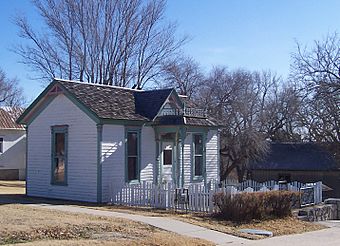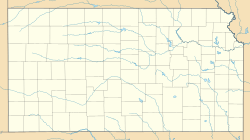Dalton Gang Hideout and Museum facts for kids
Quick facts for kids |
|
|
Dalton Gang Hideout and Museum
|
|

Whipple House at the Dalton Gang Hideout and Museum
|
|
| Location | 502 S. Pearlette St. Meade, Kansas |
|---|---|
| Area | 1.2 acres (0.49 ha) |
| Architectural style | Victorian |
| Website | The Dalton Gang Hideout |
| NRHP reference No. | 14001121 |
| Added to NRHP | January 7, 2015 |
The Dalton Gang Hideout and Museum is a fun place to visit in Meade, Kansas. It includes an old house, a museum inside a barn, and other interesting things. Local stories say that the famous outlaw Dalton Gang brothers used to hide here. This was the home of their sister and her husband. The property was fixed up in 1941 and became a historic site. It was officially added to the National Register of Historic Places on January 7, 2015.
The First Owners
Eva Dalton, who was the sister of the Dalton Gang brothers, married John N. Whipple in Meade, Kansas, on October 25, 1887. John Whipple owned a general store in town. He sold many different items like food and clothes.
Whipple bought the house and land for $400. But he lost it in 1892. The new family, the Marshalls, moved in. They found a secret tunnel! It went from a closet under the stairs, through the basement, and all the way to the barn. The Marshall's daughter remembered strangers coming into their house through this secret closet. They would leave their horses in the barn. The family later sealed up the tunnel.
The Hideout Legend
The Dalton brothers were a group of robbers in the 1800s. They were known for stealing from banks and trains. Some historians say they were "social bandits." This means people in their communities might have helped them hide or kept quiet about what they knew. These outlaws often lived openly among their friends and neighbors.
The idea that the Dalton brothers hid at Eva's house comes from a local legend. This story became popular in the 1900s. The brothers were known to be in Meade before their crime spree started in 1890. But there is no real proof they were there after that time.
One of the first times the legend was mentioned was by the Wayne Settle family. They owned the house in the 1930s. They said they didn't know about the secret tunnel until a stranger visited. This stranger claimed to have been part of the Dalton Gang. He even showed them where the tunnel entrance was.
When the property was turned into a tourist spot in 1940, more stories added to the legend. A local newspaper owner, Frank Fuhr, claimed he used a telescope to watch the gang enter the barn but never leave. Another woman, Belle Mackey, told a newspaper that Emmett Dalton, one of the gang members, stayed at her ranch for two days in 1892. She said she didn't know who he was until she saw his picture in a newspaper much later.
Restoring the Hideout
The Works Progress Administration (WPA) was a government program in the 1930s and 1940s. It created jobs during the Great Depression. The WPA helped fix up old buildings and build new things like parks. The National Youth Administration (NYA) was part of the WPA. It helped young people aged 16 to 25 find jobs.
The Dalton Gang museum and park opened in July 1940. The Meade Chamber of Commerce bought the Whipple property. In 1941, the WPA, NYA, and the Chamber of Commerce worked together. They restored the old buildings and added new ones. The main part was the wooden Whipple Victorian house. The original front door is still there, but visitors now enter the house through the tunnel after going into the barn first.
The two-story barn, with its secret tunnel, was rebuilt by the WPA in 1941. The museum is on the second floor of the barn. The museum used to be in the Whipple house. The barn has a wooden roof and frame. Its foundation is made of concrete. The 96-foot long tunnel is about 32 inches wide and 80 inches high. It was also built by the WPA and NYA in 1941. Other things built in 1941, like a wishing well, an outdoor stove, and a stone wall, are also part of the historic site.
Later Additions and Recognition
Dad's Country Store was built in 1951. It is also considered a historic part of the property. In 1959, a special bell was placed in the yard to honor Walter Dingle. The Heritage House was given to the park and moved there in 1969. The entire property was officially listed on the National Register of Historic Places on January 7, 2015.



